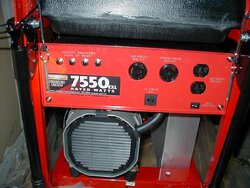I just got a new clamp ammeter that measures inrush current. My 240 volt deep well pump measured 60 amps on startup and 11 amps continuous. This is on one of the 120 volt legs (readings were similar for both legs). What is the peak inrush current: 60 amps, at 240 volts? That would be 14,400 watts. Or, should I be multiplying by 120 volts and coming up with 7,200 watts? My generator, which is rated at 7550/13500 continuous/surge watts, has run this load in the past.
Sorry if this is a dumb question. I'll be looking more on the web as well.
Sorry if this is a dumb question. I'll be looking more on the web as well.


